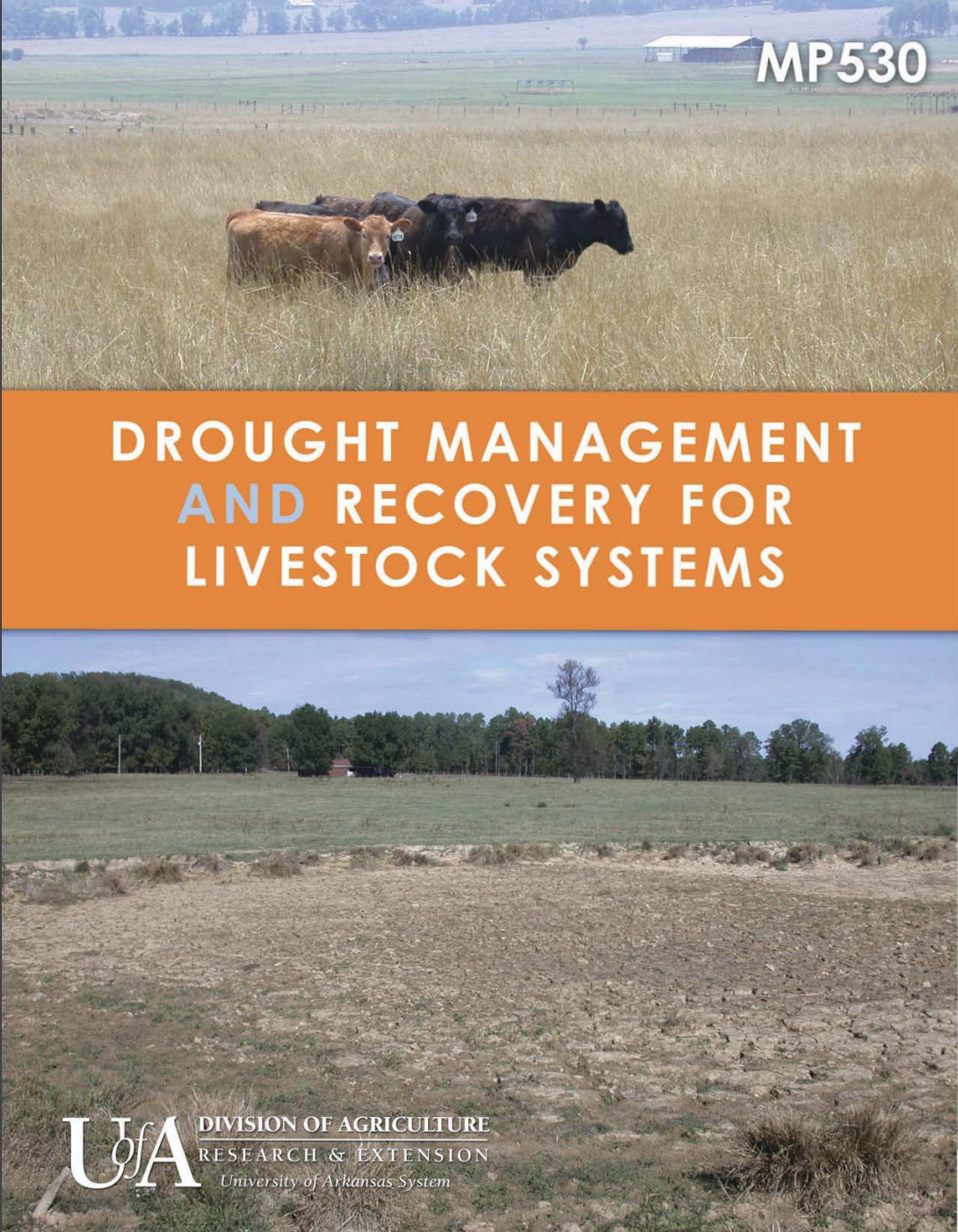Growing drought squeezing Arkansas cattle producers
July 6, 2018
By Mary Hightower
U of A System Division of Agriculture
- Drought in nearly 80 percent of Arkansas
- Heat, dry weather cutting forage production
- See Drought Management and Recovery in Livestock Systems: https://www.uaex.uada.edu/publications/pdf/mp530.pdf
(670 words)
Download Word version
LITTLE ROCK – Drought has put its grip on nearly 80 percent of Arkansas and the state’s ranchers are having to make decisions to handle rapidly dwindling amounts of forage for their cattle.
The U.S. Drought Monitor map released Thursday showed the 79.83 percent of the state with some drought rating. Severe drought appeared in 2.19 percent of the state. Moderate drought covered some 35.85 percent of Arkansas. (See: http://droughtmonitor.unl.edu/CurrentMap/StateDroughtMonitor.aspx?AR )

The 6-10 day outlook from the Climate Prediction Center showed a better than 40 percent chance all of the state would see above normal temperatures through July 15, but normal odds of getting rain over the same period. However, the chances for some precipitation were in the forecast from Sunday through Tuesday, according to the National Weather Service at Little Rock.
“Within the last week, week-and-a-half, I’ve been getting calls and emails from people looking for hay,” Brian See, interim Marion County extension staff chair for the University of Arkansas System Division of Agriculture, said Friday.
He recounted a recent visit to a client who asked See to look at his pasture. “It was just crunchy. Just burned up,” See said. “There was nothing green except for patches of crabgrass. He hadn’t had rain in a month.”
“Some people hadn’t even gotten their first cutting of hay,” he said. “Some did and it was half of normal.”
So far, ponds have been holding, See said. “I haven’t heard of any water problems yet.”
John Jennings, extension forage specialist for the Division of Agriculture, said that even with the scattered showers of the last few days, “pasture recovery will require more than a few rain showers due to the dry soil profile and continued high temperatures.”
Ranchers will need to make management decisions quickly during drought to maintain enough forage to feed the herd.
“Culling poor performing animals is one choice to reduce the amount of forage needed, but improving pasture management can also be effective,” he said. “Producers who plan ahead get themselves into a position to take advantage of better growing conditions when those conditions eventually arrive.”
Where pastures still have forage, Jennings recommended “Protecting any remaining standing forage by shutting pasture gates or by using temporary electric fencing. Manage it like standing hay and feed it a few acres at a time to make it last as long as possible.”
Other practices for managing during drought:
- Rotational grazing is a good drought management tool. Rotational grazing helps maintain forage growth longer into a drought period than continuous grazing. Overgrazing weakens plants and leads to shortened root systems causing them to respond more slowly to rain and fertilizer than do healthier plants. Rotating pastures during drought conditions can help protect the pastures that will be needed for summer production.
- Although all forages produce yield less during drought, some species including bermudagrass and KY-31 tall fescue, can tolerate heavy grazing and still survive. Manage grazing pressure carefully during prolonged dry weather to prevent loss of high quality forage species such as novel endophyte fescue, clover, and orchardgrass.
- Feeding hay and limit grazing during dry weather can stretch available forage on drought-stressed pastures. If all pastures are already grazed short and no regrowth is being produced then cattle can be shut in a single pasture and fed hay until better growing conditions arrive. This practice may be detrimental to that pasture, but it helps protect forage in other pastures that will needed for later grazing.
Where pastures are grazed down to the soil and ranchers are feeding hay, “management strategies must focus on drought recovery.”
Don Hubbell, head of the Livestock and Forestry Station in Batesville, said now “is also a good time for producers to be thinking about stockpiling fescue and bermudagrass for winter feeding.
“I know they are thinking about today, but we need to also be looking ahead to set up our fall pasture plans,” he said. “Rotational grazing will help set up the stockpiling scenario. If the dry weather ends, rotational grazing will promote more forage growth, distribute manure and urine more evenly and possibly reduce fertilizer cost.”
For more information on managing during drought, download or read: "Drought Management and Recovery in Livestock Systems": https://www.uaex.uada.edu/publications/pdf/mp530.pdf.
For more information about cattle and forage production, contact your county extension office or visit www.uaex.uada.edu.
About the University of Arkansas System Division of Agriculture
The University of Arkansas System Division of Agriculture’s mission is to strengthen agriculture, communities, and families by connecting trusted research to the adoption of best practices. Through the Agricultural Experiment Station and the Cooperative Extension Service, the Division of Agriculture conducts research and extension work within the nation’s historic land grant education system.
The Division of Agriculture is one of 20 entities within the University of Arkansas System. It has offices in all 75 counties in Arkansas and faculty on five system campuses.
Pursuant to 7 CFR § 15.3, the University of Arkansas System Division of Agriculture offers all its Extension and Research programs and services (including employment) without regard to race, color, sex, national origin, religion, age, disability, marital or veteran status, genetic information, sexual preference, pregnancy or any other legally protected status, and is an equal opportunity institution.
# # #
Media Contact: Mary Hightower
Dir. of Communication Services
U of A System Division of Agriculture
Cooperative Extension Service
(501) 671-2126
mhightower@uada.edu
Related Links